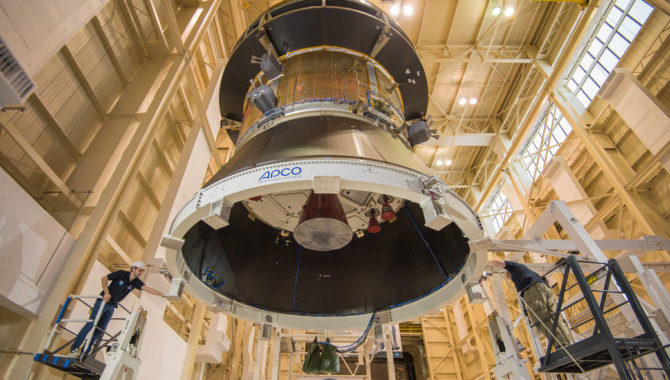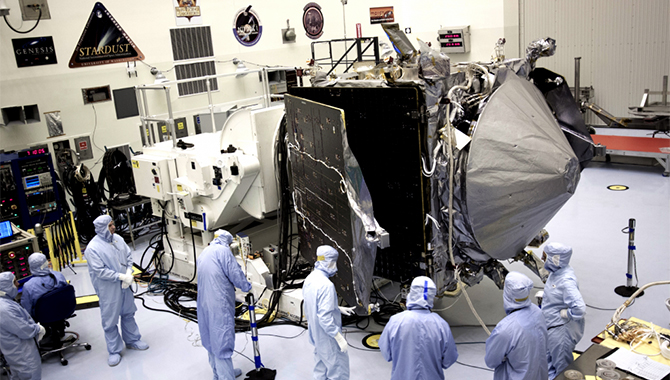
Earlier this year, engineers and technicians at Glenn Research Center’s Plum Brook Station prepared to begin a series of tests designed to verify the structural integrity of Orion’s European Service Module, which is being provided by ESA for EM-1.
Photo Credit: NASA
A recent Government Accountability Office (GAO) report assessed the progress and challenges facing the development of NASA’s Orion spacecraft.
The Orion Multi-Purpose Crew Vehicle is the first spacecraft in 40 years designed to transport astronauts into deep space. Orion overcame a key challenge in December 2014 with its maiden mission: Exploration Flight Test 1 (EFT-1). During the virtually flawless unmanned flight, Orion faced the rigors of space beyond low Earth orbit (LEO) to test a range of systems that are critical for crew safety.
The next milestone for Orion will be Exploration Mission 1 (EM-1), scheduled for late 2018. In EM-1, Orion will be integrated with the Space Launch System (SLS) to confirm that major systems on the spacecraft, such as communications, navigation, and software, function as intended. Orion and the SLS will then move on to Exploration Mission 2 (EM-2), the first crewed test of the key components of NASA’s human exploration program. EM-2 will assess how Orion interacts with astronauts on board. Upon completing the two flights, Orion will be ready to take crew beyond LEO for longer missions into cis-lunar space and, eventually, to Mars.
Orion has already passed several milestones on the path toward EM-1 ad EM-2. In September 2015, Orion completed Key Decision Point C (KDP-C), a process of programmatic assessment and technical progress review. In March 2016, Orion and the associated Ground Systems Development and Operations (GSDO) Program completed a joint critical design review (CDR). The SLS completed its CDR in October 2015.
The GAO regularly assesses the progress of NASA’s human exploration program. A recent report on Orion stated that the program has overcome several technical challenges and reduced risk for the crew capsule through design modifications. The program still faces hurdles, including development of the heatshield, software, parachute deployment system, and the European Service Module (ESM), which is being handled by ESA (the European Space Agency), as well as the re-qualification of heritage hardware such as the repurposed engines from the space shuttle. According to the report, these areas exhibit the potential for cost and schedule growth as Orion enters the integration and test phase for EM-1, and could impact program cost and schedule reserves. Furthermore, the GAO noted that the cost and schedule estimates for the program may not be reliable per best practices for developing estimates.
Cost and schedule risks are underscored by the program’s decision to pursue an aggressive internal launch readiness date (LRD) of August 2021 for EM-2, rather than adhering to the April 2023 LRD established in KDP-C. The 2023 LRD is based on a Joint Confidence Level (JCL) of 70%, an agency best practice that indicates a 70% likelihood that the program will be completed in accordance with the stated budget and schedule. In contrast, the internal LRD of 2021 is associated with a 40% JCL, suggesting delivery could require funds beyond those currently requested by NASA. In addition, some tasks have been deferred, which could impact cost and schedule reserves in the future. The program has stated that while it continues to work toward the earlier date, it remains on track for the 2023 LRD.
The GAO recommended that the program update cost and schedule estimates, and perform a new JCL based on these estimates. Doing so will provide NASA and Congress with greater insight into the program’s anticipated cost and schedule to inform future decision making. The GAO also encouraged the agency to analyze the cost of any deferred work compared to program reserves. This approach will enable a broader understanding of the road ahead for Orion—and, consequently, for NASA’s human exploration program as a whole.
Read an APPEL News article on a recent GAO report for the SLS.









